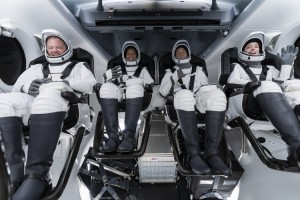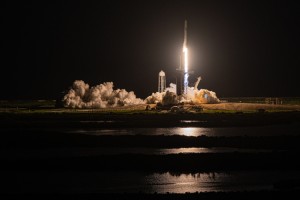Civilians Circle the Planet
Thursday, September 16th, 2021On Wednesday evening, four people blasted off from Cape Canaveral, Florida, for a multi-day orbital flight. But none of them were trained astronauts. Nor were they members of any branch of the armed services. They were part of the first all-civilian orbital spaceflight in history.
American entrepreneur Jared Isaacman financed the mission. Determined to prevent the flight from being viewed as a billionaire’s thrill-seeking jaunt into space, Isaacman turned the event into a fundraiser for St. Jude Children’s Research Hospital, with the goal of raising $200 million. He solicited donations and held contests to determine who would join him on the flight. The three winners were physician’s assistant and former St. Jude’s patient Hayley Arceneaux, data engineer Chris Sembroski, and geoscientist Sian Proctor. Now, the quartet is orbiting Earth, performing experiments and conducting outreach activities. Their capsule will likely splash down in the Atlantic Ocean over the weekend.

The crew of Inspiration4 participate in a launch day rehearsal on September 13, 2021 : (L-R) Sembroski, Proctor, Isaacman and Arceneaux.
Credit: SpaceX
After two decades of mishaps and false starts, the space tourism industry finally appears poised to take off. Isaacman’s flight is the third major space tourism milestone to occur this year. In July, entrepreneurs Jeff Bezos and Richard Branson competed to reach space first aboard rockets from their respective space companies, with Branson edging out Bezos by less than 10 days.
But Isaacman purchased his flight neither from Bezos’s company, Blue Origin, nor Branson’s company, Virgin Galactic. The Crew Dragon and Falcon 9 rocket that took Inspiration 4 to orbit were manufactured by the American aerospace company SpaceX. Neither Bezos’s nor Branson’s craft were designed to fly as high or as long as SpaceX’s capsule. Isaacman and his fellow travelers will reach an altitude of 357 miles (575 kilometers) above Earth, higher than the orbits of both the International Space Station and the Hubble Space Telescope.
The founder of SpaceX, South African-born entrepreneur Elon Musk, declined to directly participate in the billionaire’s space race. Instead, his company has focused on flying Falcon 9 and Crew Dragon missions for paying customers. SpaceX also spent the year expanding its satellite internet constellation called Starlink and developing its next rocket, the colossal Starship.
Reuse has been the key to the space tourism boom. Blue Origin and Virgin Galactic plan to operate their spacecraft many times to achieve profitability. The Falcon 9 booster that launched Isaacman and his crew into orbit landed on a specialized drone ship in the Atlantic Ocean. It was the booster’s third flight; and SpaceX will now inspect it and prepare it to fly again. The Crew Dragon capsule that is hosting the Inspiration 4 mission, Resilience, previously brought a crew of astronauts to the ISS in the Crew-1 mission. Resilience is scheduled to host another space tourism mission next year.



